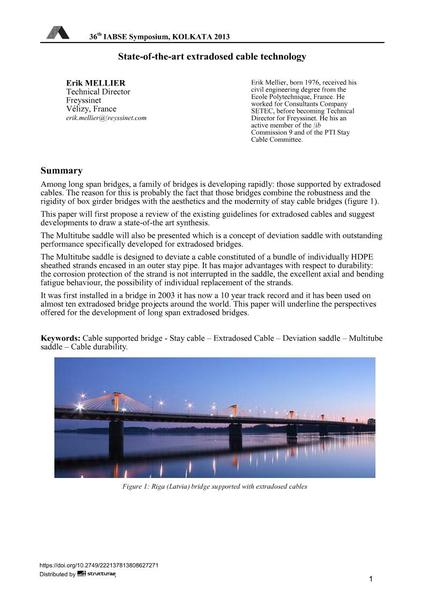State-of-the-art extradosed cable technology

|
|
|||||||||||
Bibliographic Details
| Author(s): |
Erik Mellier
|
||||
|---|---|---|---|---|---|
| Medium: | conference paper | ||||
| Language(s): | English | ||||
| Conference: | IABSE Symposium: Long Span Bridges and Roofs - Development, Design and Implementation, Kolkata, India, 24-27 September 2013 | ||||
| Published in: | IABSE Symposium Kolkata 2013 | ||||
|
|||||
| Page(s): | 1-8 | ||||
| Total no. of pages: | 8 | ||||
| Year: | 2013 | ||||
| DOI: | 10.2749/222137813808627271 | ||||
| Abstract: |
Among long span bridges, a family of bridges is developing rapidly: those supported by extradosed cables. The reason for this is probably the fact that those bridges combine the robustness and the rigidity of box girder bridges with the aesthetics and the modernity of stay cable bridges (figure 1). This paper will first propose a review of the existing guidelines for extradosed cables and suggest developments to draw a state-of-the art synthesis. The Multitube saddle will also be presented which is a concept of deviation saddle with outstanding performance specifically developed for extradosed bridges. The Multitube saddle is designed to deviate a cable constituted of a bundle of individually HDPE sheathed strands encased in an outer stay pipe. It has major advantages with respect to durability: the corrosion protection of the strand is not interrupted in the saddle, the excellent axial and bending fatigue behaviour, the possibility of individual replacement of the strands. It was first installed in a bridge in 2003 it has now a 10 year track record and it has been used on almost ten extradosed bridge projects around the world. This paper will underline the perspectives offered for the development of long span extradosed bridges. |
||||
| Keywords: |
cable-supported bridge stay cable extradosed cable Deviation saddle Multitube saddle cable durability
|
||||
